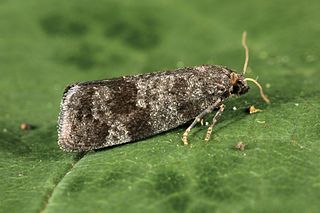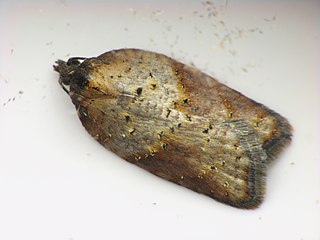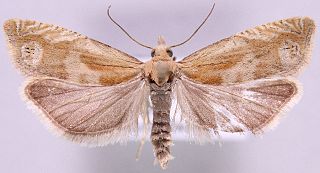
Acleris comariana, the strawberry tortrix, is a moth of the family Tortricidae. It is found in Europe, the Caucasus, Amur, Kamchatka, China, Korea and Japan.

Choristoneura rosaceana, the oblique banded leaf roller or rosaceous leaf roller, is a moth of the family Tortricidae. It is native to North America, but has been accidentally introduced into other parts of the world.
Licigena is a monotypic genus of moths belonging to the subfamily Olethreutinae of the family Tortricidae. Its sole species is Licigena sertula, which has been found in Sri Lanka. Both the genus and species were first described by Alexey Diakonoff in 1982.

Neosphaleroptera is a genus of moths belonging to the subfamily Tortricinae of the family Tortricidae. It contains only one species, Neosphaleroptera nubilana, which is found in almost all of Europe and the Near East.
Symphygas is a genus of moths belonging to the subfamily Tortricinae of the family Tortricidae. It contains only one species, Symphygas nephaula, which is found in Australia, where it has been recorded from Tasmania. The habitat consists of subalpine open forests at altitudes between 950 and 1,100 meters.

Phalonidia contractana is a moth of the family Tortricidae. It is found in southern Europe, Dalmatia, Macedonia, Hungary, Romania, Bulgaria, Greece, Ukraine, southern Russia (Sarepta), Uralsk, Turkey, Kuldscha, Afghanistan, Kashmir, Lebanon, China, Iran, Pakistan and Kyrgyzstan.

Rhyacionia duplana, the summer shoot moth or Elgin shoot moth when referring to subspecies logaea, is a moth of the family Tortricidae. It is found from northern and central Europe to eastern Russia, China and Japan. It has also been reported from Korea, but it has not been found in recent studies.

The Tortricini are a tribe of tortrix moths.

Archips crataegana, the brown oak tortrix, is a moth of the family Tortricidae. It is found in most of Europe east to Japan.

Amorbia cuneanum, the western avocado leafroller moth, is a species of moth of the family Tortricidae. It is found from Baja California, Mexico, to south-western Canada. To the east, the range extends to Arizona and Idaho in the United States.
Amorbia knudsoni is a species of moth of the family Tortricidae. It is found in the United States in western Texas, where it is found at altitudes between 1,700 to 1,900 meters.
Amorbia nuptana is a species of moth of the family Tortricidae. It is found from Venezuela to Guatemala, where it is found at altitudes between 650 and 1,620 meters.
Gorytvesica sachatamiae is a species of moth of the family Tortricidae. It is found in Pichincha Province, Ecuador.
Transtillaspis plagifascia is a species of moth of the family Tortricidae. It is found in Ecuador in Tungurahua, Azuay and Loja provinces.

Eucosma hohenwartiana, the bright bell, is a species of moth of the family Tortricidae. It is found in China, Central Asia, North Africa and Europe, where it has been recorded from Sardinia, Sicily, Ireland, Great Britain, Spain, France, Germany, the Benelux, Denmark, Austria, Switzerland, Italy, the Czech Republic, Slovakia, Slovenia, Hungary, Poland, Romania, Bosnia and Herzegovina, Norway, Sweden, Finland, the Baltic region and Russia. The habitat consists of dry open areas and grassland.
Beryllophantis cochlias is a species of moth of the family Tortricidae. It is found in Papua New Guinea and West Irian. The habitat consists of montane rain-forests.
Beryllophantis alphophora is a species of moth of the family Tortricidae. It is found in Papua New Guinea.
Beryllophantis microtera is a species of moth of the family Tortricidae. It is found in Papua New Guinea. The habitat consists of montane rain forests with Nothofagus.
Beryllophantis asticta is a species of moth of the family Tortricidae. It is found in Papua New Guinea. The habitat consists of montane rain forests.
Beryllophantis poicila is a species of moth of the family Tortricidae. It is found in Papua New Guinea. The habitat consists of montane rain forests with Nothofagus.








